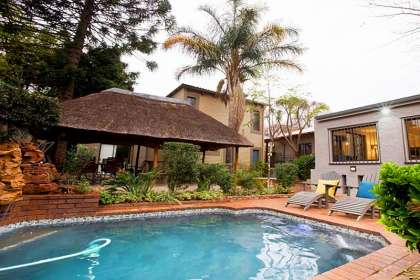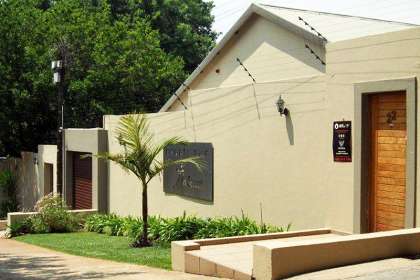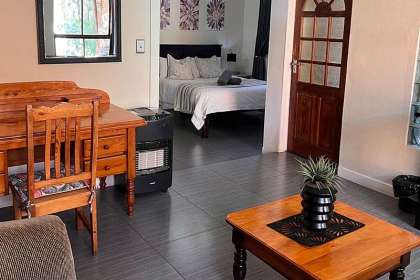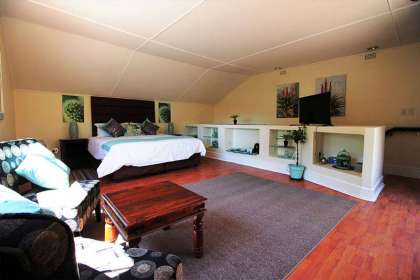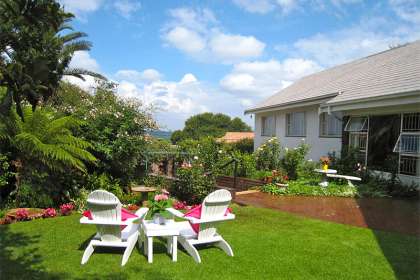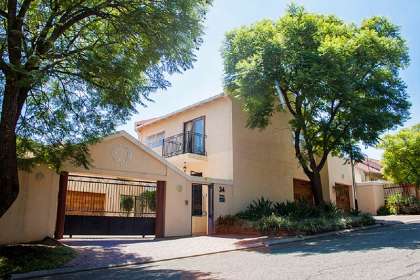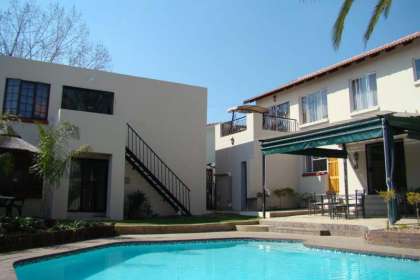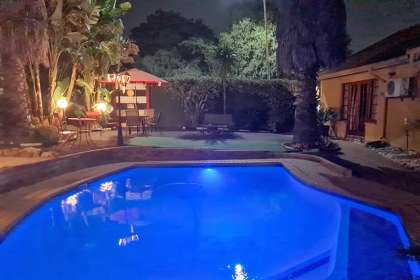Klipriviersberg Nature Reserve - Johannesburg South
Klipriviersberg Nature Reserve - Johannesburg South
The Klipriviersberg Nature Reserve is conveniently situated in Johannesburg South and is only 10 km from the center of Johannesburg, 5 km from Soweto and 25km from Sandton. The reserve which was proclaimed in 1984 is a 680 hectare stretch of open veld and koppies.
The Bloubosspruit winds its way through the reserve and along with 650 indigenous plants and trees, is home to over 150 different species of birds. The terrain is mainly grassland, interspersed with indigenous shrubs and trees and rocky outcrops. One of the over 50 species of trees found on the reserve is the Buffalo Thorn which is used for several different purposes. Its bark is used for treating sprains, while its thorns have symbolic meaning, symbolising both the future and the ancestors. Its leaves are used to make a tea which is used as an aphrodisiac and legend has it that sheltering under it branches during a storm will keep you safe from lightening as lightening wont strike the tree. A diary from the time was found and indicates that lion, caracal, lynx and genet were found on the farm. Today none of these are present but you are likely to spot mountain rhebuck, duiker, jackal, mongoose, porcupine and dassie in the Reserve.
Klipriviersberg Nature Reserve has a history which can be traced back to the mid 1800s and even further back to the 1500s when the area was occupied by Tswana pastoralists during the Iron Age. Aerial photographs of the reserve show 19 stone-walled settlements which date back to the early 1500s.
Around 1850 one of the early Voortrekkers, Sarel Marais and his family settled in an area just above the Bloubosspruit which is now in the southern part of the reserve. Today there are still remains of the farmstead, these include the original farmhouse, a wagonhouse, an orchard, an irrigation furrow and a cemetery. The simple rectangular farmhouse which originally had a thatched roof was burnt down on two separate occasions, once in 1943 and again in 1980, today only the walls remain. Only one wall remains of the wagonhouse, but this wall is an excellent example of what is known as the pise-de-tere building technique. A low stone wall and two entrance stones mark what was once the orchard. Until 1989 the orchard was planted with peach, pear, fig and pomegranate trees, but these unfortunately no longer exist. Peaches from the orchard were used to make Witblitz which was a type of local schnapps and poplar trees were also grown to be used in building and fencing. Aproximately 500 metres north of the farmhouse lies a now overgrown and vandalised family cemetery where Sarel Marais was buried in 1897 at the age of 83.
In 1895 it was decided to build a dam in the northern end of the reserve, the Vierfontein Dam Scheme was meant to have supplied the needs of the rapidly growing town, but when the Anglo Boer War broke out in four years later in 1899 the plans were permanently shelved. It is interesting to note that had the dam been built as was proposed the suburbs of Mondeor, Alan Manor, Suideroord and Winchester Hills Ext 1 would never have existed. Today you can still see the foundations of the dam wall, which consisted of large stacked quartzite blocks, at the northern end of the reserve. The Bloubosspruit flows through the centre of the wall, through the reserve and out into the Klip River.
The reserve is run by a partnership between the Klipriviersberg Nature Reserve Association, with some 800 members, the Johannesburg City Council and Gauteng Nature Conservation. It has a network of trails running through it, the two longest ranging from 5.8 kilometres to nine kilometres and organised walks take place every second and fourth Sunday of the month. Mountain biking and cross-country groups also enjoy the trails through the Reserve. There are also various activities which take place on the reserve, such as the fun day which is organised by Ecodad, on Environment Day in June, where visitors are given route maps, and answer questions whilst walking around the reserve. Twice a year the Klipriviersberg Nature Reserve Association organises Spring and Autumn days which consist of three-hour walks followed by a social braai (barbecue). Plans are also underway to build stables which will house horses to be used in horse trails as well as for security patrols around the Reserve.
Klipriviersberg Nature Reserve, which has several access points: one near the farmhouse on Impala Drive; one through the Recreation Centre on Peggy Vera Road; and the most popular one, via Frandaph Drive in Mondeor, where the old dam wall is located, is unfenced and is used by locals to walk their dogs. Conservationists working in the reserve say that there have been no reported incidents of vandalism or muggings in the reserve.
The reserve offers a beautiful natural space for hiking, bird-watching, and enjoying indigenous flora and fauna right in the city's vicinity.
Phone: see website (various numbers)
Email: see website
Website: https://klipriviersberg.org.za
Accommodation Near Klipriviersberg Nature Reserve - Johannesburg South
Melville Gap Guest House
Self Catering Apartment, Flatlet Accommodation in Melville
11.6km from Klipriviersberg Nature Reserve - Johannesburg SouthMellville Gap Guest House is situated a stone's throw from the Bohemian suburb of Melville's famous 7th Street with its vibe atmosphere, pavement cafes, cozy restaurants, antique/vintage stores and cocktail clubs, we are in the perfect location... …see more for bookings / enquiries and info.
7th Street Guest House
Bed & Breakfast Accommodation in Melville
12km from Klipriviersberg Nature Reserve - Johannesburg South7th Street Guest House offers bed and breakfast accommodation in Melville, Johannesburg. With 13 luxury en suite rooms equipped with DSTV, Wifi internet access, heaters, hairdryers, fans, digital safes, coffee/tea facilities and bar fridges stocked... …see more for bookings / enquiries and info.
Forest Town Guest Cottages
Self Catering House, Cottage, Chalet Accommodation in Forest Town
12.4km from Klipriviersberg Nature Reserve - Johannesburg SouthForest Town Guest Cottages situated in Forest Town in Johannesburg. These attractively and comfortably furnished villas are self-contained, separate and private, 1- and 2-bedroom villas to suit families, the business traveller and tourists. …see more for bookings / enquiries and info.
House on York
Self Catering Apartment, Flatlet Accommodation in South Kensington, Johannesburg
13.8km from Klipriviersberg Nature Reserve - Johannesburg SouthHouse on York offers both bed and breakfast and self catering accommodation in the leafy suburb of South Kensington in Johannesburg. Within walking distance of beautiful antique shops and quaint little coffee shops in famous Queen Street. …see more for bookings / enquiries and info.
House On Morninghill
Self Catering Apartment, Flatlet Accommodation in Bedfordview, East Rand
15.4km from Klipriviersberg Nature Reserve - Johannesburg SouthHouse on Morninghill offers self catering flatlet accommodation in Bedfordview on the Johannesburg East Rand. Our elegant, well-designed en-suite rooms (4-sleeper, 2x 2-sleepers), are individually decorated with style and comfort in mind. We are situated …see more for bookings / enquiries and info.
Panhandle Place Cottages
Self Catering Apartment, Flatlet Accommodation in Johannesburg Area
16.6km from Klipriviersberg Nature Reserve - Johannesburg SouthPanhandle Place Cottages are lovely self-catering units in a beautiful garden setting with views of the Johannesburg city skyline. We are centrally placed in an old Johannesburg suburb with tree-lined streets, safe for walking and jogging. …see more for bookings / enquiries and info.
Apartment at 34 Columbine
Self Catering Apartment, Flatlet Accommodation in Randpark
18.8km from Klipriviersberg Nature Reserve - Johannesburg SouthThe Apartment is a double story self catering fully equipped with linen and towels. It can sleep 4 persons. Downstairs it boasts an open plan kitchen - equipped with dishwasher, microwave, fridge opening on to the dining room area, a bathroom... …see more for bookings / enquiries and info.
Louhallas
Self Catering Apartment, Flatlet Accommodation in Edenvale
20.6km from Klipriviersberg Nature Reserve - Johannesburg SouthLouhallas provides self catering accommodation in Edenvale in Johannesburg's East Rand, Gauteng. Set in Central Edenvale, close to shopping centres, banks and a variety of other amenities. We offer 3 fully furnished self-catering cottages... …see more for bookings / enquiries and info.
President Lodge
Bed & Breakfast Accommodation in Edenvale
21.5km from Klipriviersberg Nature Reserve - Johannesburg SouthPresident Lodge offers bed and breakfast accommodation in Edenvale on the Johannesburg East Rand, Gauteng. President Lodge is a jewel of a guest house, within 10 minutes' drive from OR Tambo International Airport and close to major... …see more for bookings / enquiries and info.
3 Brothers B&B
Bed & Breakfast Accommodation in Edenvale
21.8km from Klipriviersberg Nature Reserve - Johannesburg South3 Brothers Bed and Breakfast is located in Edenvale on the East Rand of Johannesburg in Gauteng. 3 Brothers is situated in Edenvale, a quiet, tranquil and secure residential area. It's central and close to all major routes and business parks. …see more for bookings / enquiries and info.
- Mayfield Park (2.17km)
- Mondeor (2.19km)
- Winchester Hills (2.66km)
- Rispark (2.70km)
- Johannesburg South (2.81km)
- Kibler Park (2.90km)
- Gillview (3.20km)
- Glenvista (3.29km)
- Aspen Hills Nature Estate (3.52km)
- Gleneagles (3.81km)
- Ridgeway (3.84km)
- Mulbarton (4.08km)
- Meredale (4.09km)
- Crown Gardens (4.18km)
- Southgate (4.42km)
- Glenvista Country Club - Glenvista, Johannesburg (4.27km)
- Gold Reef City Theme Park - Johannesburg South (5.60km)
- Gold Reef City Casino - Johannesburg (5.60km)
- Apartheid Museum - Ormonde, Johannesburg (5.63km)
- Johannesburg Expo Centre - Nasrec, Johannesburg (6.19km)
- Rand Show - Nasrec, Johannesburg (6.36km)
- Turffontein Racecourse - Johannesburg, Gauteng (6.38km)
- FNB Stadium - Nasrec, Johannesburg (6.78km)
- Eye of Africa Golf Club - Southern Johannesburg (6.85km)
- James Hall Museum of Transport - Johannesburg (7.07km)
- Wemmer Pan - Johannesburg, Gauteng (7.61km)
- Chris Hani Baragwanath Hospital - Soweto, Johannesburg (8.24km)
- Nelson Mandela Shadow Boxer Statue - Johannesburg (8.89km)
- SAB World Of Beer - Newtown, Johannesburg (9.08km)
- Oriental Plaza - Fordsburg, Johannesburg (9.10km)
- Gandhi Square Precinct - Johannesburg (9.14km)
- Sci-Bono Discovery Centre - Johannesburg (9.15km)
- Workers' Museum - Newtown, Johannesburg (9.19km)
- Mary Fitzgerald Square - Newtown, Johannesburg (9.25km)
- Newtown Diwali Festival - Newtown, Johannesburg (9.26km)
- Museum Africa - Newtown Cultural Precinct, Johannesburg (9.32km)
- Arts Alive Festival - Newtown, Johannesburg (9.34km)
- Market Theatre - Newtown, Johannesburg (9.34km)
- Absa Art Gallery - Johannesburg (9.44km)
- Absa Money Museum - Johannesburg (9.52km)
- Reading Country Club - Alberton, Johannesburg (9.60km)
- Soweto Towers - Orlando East, Soweto, Johannesburg (9.75km)
- Arts on Main - Johannesburg (9.86km)
- Maboneng Precinct - Johannesburg Central (9.96km)
- The Playground - Braamfontein, Johannesburg (10.14km)
 Klipriviersberg Nature Reserve. (Image adapted). ©
Klipriviersberg Nature Reserve. (Image adapted). ©  Klipriviersberg Nature Reserve. (Image adapted). ©
Klipriviersberg Nature Reserve. (Image adapted). © 